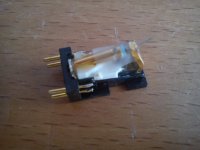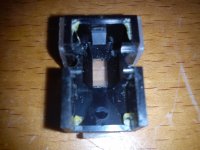yes, Nichicon´s take some time to acomodate and after that they have a sweet trebble with very good mids.
Bass is incredible.
I am using KG 15000uF in my CDP discrete output stage and they are really good.
Bass is incredible.
I am using KG 15000uF in my CDP discrete output stage and they are really good.
Mistake
Hi Felipe,
I made a mistake, and deleted the massage.
If the cap's are in the signal path THAN it's minus to minus!
In a PSU it's stacked !
Sorry for that.
Audiofanatic 😉
Hi Felipe,
I made a mistake, and deleted the massage.
If the cap's are in the signal path THAN it's minus to minus!
In a PSU it's stacked !
Sorry for that.
Audiofanatic 😉
Hi Felipe,
I made a mistake, and deleted the massage.
If the cap's are in the signal path THAN it's minus to minus!
In a PSU it's stacked !
Sorry for that.
Audiofanatic 😉
So can't increase voltage?
I already am taking that in consideration.
Just add a 3M in parallel with the 45k804.
That will keep you very close to the 500.5 pole and will give you more presence in the mids.
The C2 = 47nF with 10pF in parallel can be done latter.
You can experiment with 15.1nF but it will increase highs and tighten the bass even more.
I would Let it settle for a while... Bass is still there but more detailed.
Did you decouple the psu lines just before the shunts ?
I used 1000uF Nichicon there and it gave the needed "woomph" I was missing when I reduced the 15.7nF cap.
Nichicon (the BIG can ones) are bass heavy.
C2 47nF + 5pF (deep bass)
C3 15.25nF (more highs & definition)
C2 47nF + 5pF (deep bass)
C3 15.25nF (more highs & definition)
Did you try C2 = 47nF // 10pF ?
hi salas,
seems like getting the targeted idss of 8-8.5ma is quite a challenge even going through a batch of 60 pcs.
attached are the readings of jfets i measured.
pls advise which i should use and what changes i should make do given the jfets i have. i'm looking at the "mm" version.
6.77
7.18
7.19
7.62
7.73 x2
7.92
8.22
8.43
8.6
8.66
8.84
8.9
8.97 x2
8.99 x2
9.18
9.22
9.3 x2
9.62
9.67
9.68
9.7
9.75
9.79
9.8
9.85
9.86 x2
9.87
9.9 x2
9.94
9.99
10.04
10.08
10.18
10.22
10.26 x2
10.32
10.34
10.36
10.38
10.43
10.48
10.65
10.66
10.76
10.77
10.81
10.84
10.87 x2
10.91
10.94
10.96
10.98
cheers,
johari
seems like getting the targeted idss of 8-8.5ma is quite a challenge even going through a batch of 60 pcs.
attached are the readings of jfets i measured.
pls advise which i should use and what changes i should make do given the jfets i have. i'm looking at the "mm" version.
6.77
7.18
7.19
7.62
7.73 x2
7.92
8.22
8.43
8.6
8.66
8.84
8.9
8.97 x2
8.99 x2
9.18
9.22
9.3 x2
9.62
9.67
9.68
9.7
9.75
9.79
9.8
9.85
9.86 x2
9.87
9.9 x2
9.94
9.99
10.04
10.08
10.18
10.22
10.26 x2
10.32
10.34
10.36
10.38
10.43
10.48
10.65
10.66
10.76
10.77
10.81
10.84
10.87 x2
10.91
10.94
10.96
10.98
cheers,
johari
...thanks, salas.
7.73x2 Q5, 8.97x2 Q1, 8.99x2 Q2, 8.6 & 8.66 Q3. R2=100R for real MM.
Did you try C2 = 47nF // 10pF ?
Finally by the moment ended C2 47nF & C3 15.283pF😉
Just for fun my modified Cart Denon DL103-R
Enjoy
Attachments
Merlin
I recommend to handle the open DL103R very carefully.
It seems you already have some metal dust nearby the airgap:
Once entered the airgap, the DL103R will begin to show strong distortion and therefore getting unusable.
Nearby impossible to remove in this case!
Franz
I recommend to handle the open DL103R very carefully.
It seems you already have some metal dust nearby the airgap:
An externally hosted image should be here but it was not working when we last tested it.
Once entered the airgap, the DL103R will begin to show strong distortion and therefore getting unusable.
Nearby impossible to remove in this case!
Franz
A bad example out of my collection:
Some years ago, I handled this DL103 (complete with original body) on my dirty workdesk.
After that, the cartridge began to distort (sometimes more and sometimes less) and I replaced it, not knowing the reason for this "strange" fault.
Some years later I have seen the video from Thomas Schick, how to dismantle this cartridges and I applied it to this old piece to learn the procedure.
Surprize surprize!
I was not able to remove the metal dust without destroying the coils 😡
Franz
An externally hosted image should be here but it was not working when we last tested it.
Some years ago, I handled this DL103 (complete with original body) on my dirty workdesk.
After that, the cartridge began to distort (sometimes more and sometimes less) and I replaced it, not knowing the reason for this "strange" fault.
Some years later I have seen the video from Thomas Schick, how to dismantle this cartridges and I applied it to this old piece to learn the procedure.
Surprize surprize!
I was not able to remove the metal dust without destroying the coils 😡
Franz
Last edited:
Apply tiny drops of "Copydex" over the dust/grit/metal fragments.
As the glue starts to go off, it is quite easy to lift it with the debris. The glue has very low "tack" and peals off all hard surfaces easily.
You can do this two or more times to get around the whole perimeter. It causes no harm to go around again, until all the debris is removed.
Copydex is a type of rubber solution glue, generally white in colour, available in the UK for decades.
As the glue starts to go off, it is quite easy to lift it with the debris. The glue has very low "tack" and peals off all hard surfaces easily.
You can do this two or more times to get around the whole perimeter. It causes no harm to go around again, until all the debris is removed.
Copydex is a type of rubber solution glue, generally white in colour, available in the UK for decades.
Finally by the moment ended C2 47nF & C3 15.283pF😉
Just for fun my modified Cart Denon DL103-R
Enjoy
how does it sound nacked ?
Merlin
I recommend to handle the open DL103R very carefully.
It seems you already have some metal dust nearby the airgap:
An externally hosted image should be here but it was not working when we last tested it.
Once entered the airgap, the DL103R will begin to show strong distortion and therefore getting unusable.
Nearby impossible to remove in this case!
Franz
Thanks for advice Franz
Apply tiny drops of "Copydex" over the dust/grit/metal fragments.
As the glue starts to go off, it is quite easy to lift it with the debris. The glue has very low "tack" and peals off all hard surfaces easily.
You can do this two or more times to get around the whole perimeter. It causes no harm to go around again, until all the debris is removed.
Copydex is a type of rubber solution glue, generally white in colour, available in the UK for decades.
Andrewt
Thanks for input, in Spain we have blue-tac but I'm not sure that can do the job but it's a possibility to try if don't do the job I will try "Copydex" or something similar
how does it sound nacked ?
Wow, a lot of more information, more air, less less coloured so needs to increase C3 I added 18pF to see what happens, I'll keep you informed.
Copydex is a liquid.
It seeps in around the debris and surrounds it. That makes it easy to remove the debris, as the skin of partially set rubber film is peeled out. It does no harm to leave it a bit longer until all the film has set to clear, about 5 to 15minutes if thin enough and approaching 30minutes if you apply a big glob.
Blue tac is a solid and will not flow around (no capillary action). It also does not peel well and tends to leave some blue tac behind which will be difficult to ensure 100% of the blue tac. You still have the problem of the debris lying in the gaps that the blue tac has not surrounded.
It seeps in around the debris and surrounds it. That makes it easy to remove the debris, as the skin of partially set rubber film is peeled out. It does no harm to leave it a bit longer until all the film has set to clear, about 5 to 15minutes if thin enough and approaching 30minutes if you apply a big glob.
Blue tac is a solid and will not flow around (no capillary action). It also does not peel well and tends to leave some blue tac behind which will be difficult to ensure 100% of the blue tac. You still have the problem of the debris lying in the gaps that the blue tac has not surrounded.
Last edited:
- Home
- Source & Line
- Analogue Source
- Simplistic NJFET RIAA



